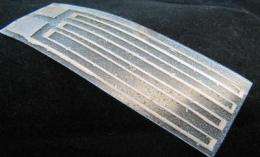Particle-free silver ink prints small, high-performance electronics

University of Illinois materials scientists have developed a new reactive silver ink for printing high-performance electronics on ubiquitous, low-cost materials such as flexible plastic, paper or fabric substrates.
Jennifer Lewis, the Hans Thurnauer Professor of Materials Science and Engineering, and graduate student S. Brett Walker described the new ink in the Journal of the American Chemical Society.
"We are really excited about the wide applicability and excellent electrical properties of this new silver ink," said Lewis, the director of the Frederick Seitz Materials Research Laboratory at the U. of I.
Electronics printed on low-cost, flexible materials hold promise for antennas, batteries, sensors, solar energy, wearable devices and more. Most conductive inks rely on tiny metal particles suspended in the ink. The new ink is a transparent solution of silver acetate and ammonia. The silver remains dissolved in the solution until it is printed, and the liquid evaporates, yielding conductive features.
"It dries and reacts quickly, which allows us to immediately deposit silver as we print," Walker said.
The reactive ink has several advantages over particle-based inks. It is much faster to make: A batch takes minutes to mix, according to Walker, whereas particle-based inks take several hours and multiple steps to prepare. The ink also is stable for several weeks.
The reactive silver ink also can print through 100-nanometer nozzles, an order of magnitude smaller than particle-based inks, an important feature for printed microelectronics. Moreover, the ink's low viscosity makes it suitable for inkjet printing, direct ink writing or airbrush spraying over large, conformal areas.
"For printed electronics applications, you need to be able to store the ink for several months because silver is expensive," Walker said. "Since silver particles don't actually form until the ink exits the nozzle and the ammonia evaporates, our ink remains stable for very long periods. For fine-scale nozzle printing, that's a rarity."
The reactive silver ink boasts yet one more key advantage: a low processing temperature. Metallic inks typically need to be heated to achieve bulk conductivity through a process called annealing. The annealing temperatures for many particle-based inks are too high for many inexpensive plastics or paper. By contrast, the reactive silver ink exhibits an electrical conductivity approaching that of pure silver upon annealing at 90 degrees Celsius.
"We are now focused on patterning large-area transparent conductive surfaces using this reactive ink," said Lewis, who also is affiliated with the Beckman Institute for Advanced Science and Technology, the Micro and Nanotechnology Lab and the department of chemical and biomolecular engineering at the U. of I.
More information: J. Am. Chem. Soc., Article ASAP DOI: 10.1021/ja209267c
Provided by University of Illinois at Urbana-Champaign




















